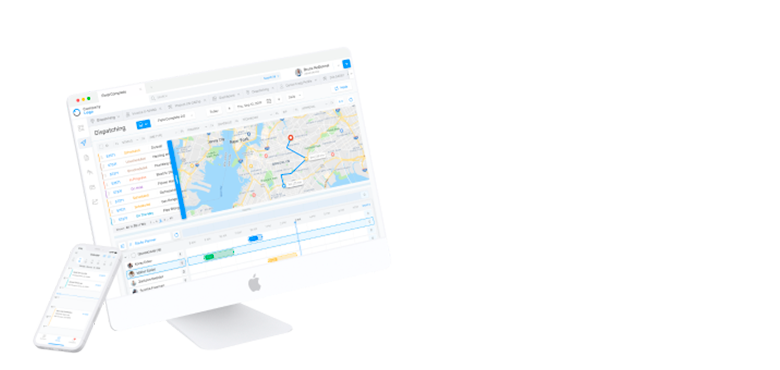Overview
Understanding the main factors influencing window cleaning costs can be daunting for contractors. Pricing models, window size and type, cleaning frequency, geographical location, window condition, specialized services, labor costs, equipment and supplies, and customer expectations all play significant roles. Each of these elements can create challenges that may feel overwhelming.
However, by recognizing how they affect pricing, contractors can take proactive steps to adjust their strategies. This not only helps them remain competitive but also ensures they meet customer needs effectively. By embracing these insights, contractors can feel empowered to navigate the complexities of their industry with confidence and compassion.
Introduction
In the competitive landscape of window cleaning services, contractors often find themselves grappling with the complexities of pricing. This challenge can feel overwhelming, as understanding the myriad factors that influence costs is essential for those aiming to thrive. From the size and type of windows to the frequency of cleaning, each element plays a significant role in shaping not only the costs but also customer satisfaction.
As businesses strive for efficiency and profitability, the emotional toll of managing these variables can be daunting. However, leveraging advanced management software like Field Complete offers a promising solution. By streamlining operations, this tool empowers contractors to optimize their pricing strategies, alleviating some of the stress associated with pricing decisions.
This article delves into the various determinants of window cleaning pricing, exploring how effective communication, labor costs, and specialized services can shape a contractor’s approach in an ever-evolving market. By equipping themselves with this knowledge, window cleaning professionals can enhance their service offerings while fostering lasting relationships with their clients. Together, we can navigate these challenges and build a supportive community in the window cleaning industry.
Field Complete: Streamlined Management for Window Cleaning Services
In the world of glass maintenance, many contractors face significant challenges, from chaotic job scheduling to difficulties in managing customer relationships. These issues can lead to frustration and inefficiency, impacting not just business operations but also the quality of service provided to clients. Field Complete understands these pain points and offers a compassionate solution designed to ease the burden. With features like:
- Streamlined job scheduling
- Efficient dispatching
- Robust customer management
this software empowers companies to automate routine tasks and focus on what truly matters—delivering quality service to their customers.
Imagine being able to subcontract with ease and access the software for free if you’re a small business. This flexibility allows you to assign tasks effortlessly and match the right job with the right technician with just a single click, significantly enhancing operational efficiency. Technicians can manage their tasks on the go, thanks to the software’s mobile accessibility, while real-time tracking enables you to monitor team locations and optimize routes, ultimately boosting productivity.
By fostering better communication and cooperation among team members, Field Complete becomes an invaluable resource for businesses dedicated to improving efficiency and customer satisfaction. As one contractor shared, ‘Field Complete has transformed how we operate; it feels like a weight has been lifted off our shoulders.’ If you’re ready to discover how Field Complete can positively impact your glass maintenance business, consider arranging a demo today. Your journey towards enhanced efficiency and customer care starts here.
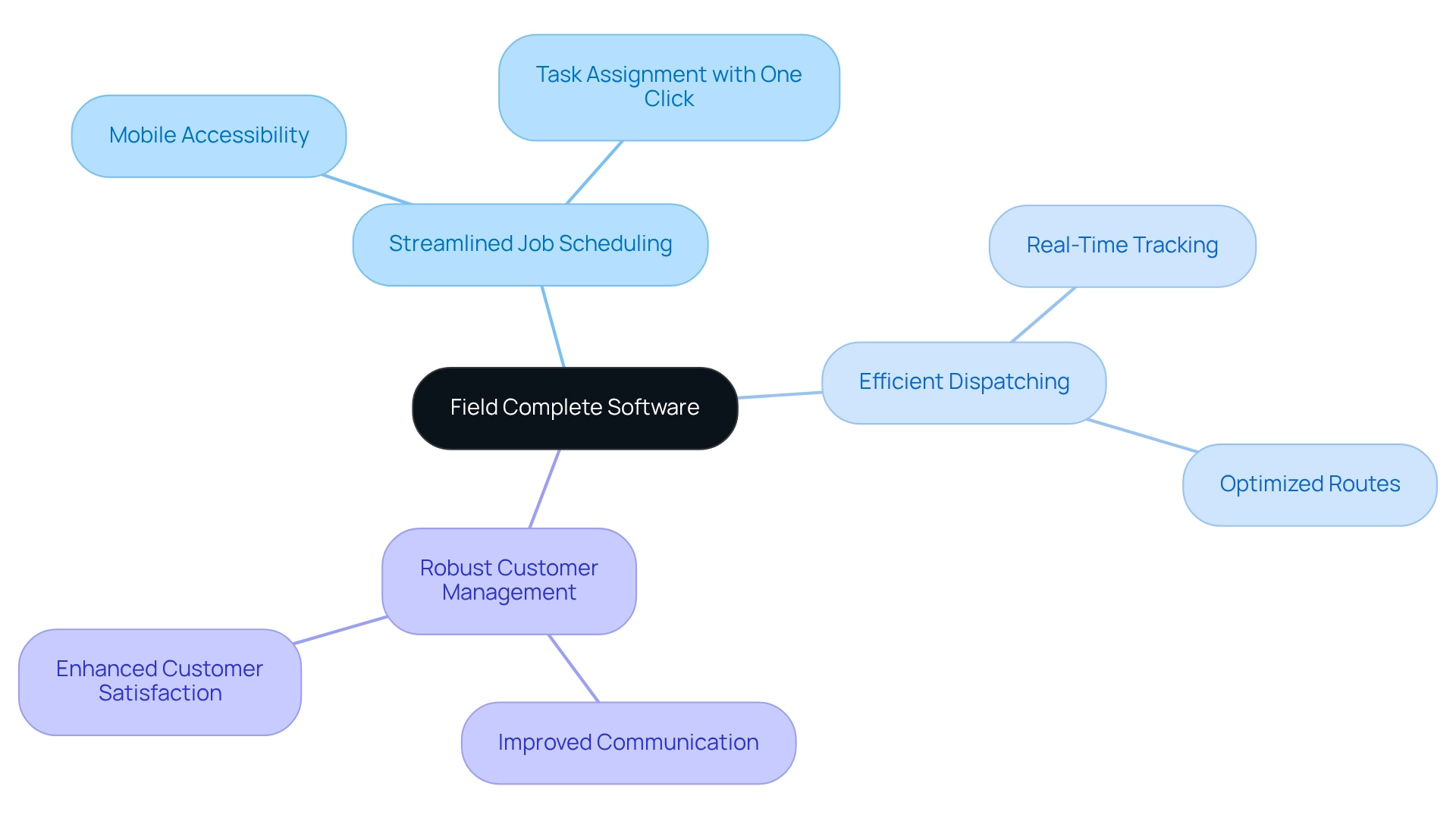
Pricing Models: Fixed, Hourly, and Per Window Rates
Window maintenance options offer a variety of structures for window cleaning cost, each tailored to meet the diverse complexities of jobs and the unique needs of clients. These models include fixed rates, hourly rates, and per opening charges. Fixed rates are often applied to standard jobs, offering customers a clear cost upfront. This approach not only simplifies the quoting process for contractors but also enhances trust with clients, fostering a sense of security in their choices.
Conversely, hourly rates shine in scenarios involving more complex tasks that may demand additional time and effort. This flexibility allows contractors to adjust costs based on the actual time invested, accommodating any unforeseen challenges that may arise during the sanitizing process.
Per pane charging is a widely used method in residential assistance, providing straightforward estimates based on the number of panes sanitized. This approach is particularly beneficial for homeowners seeking clarity in pricing, including the window cleaning cost, thereby enabling them to easily assess expenses based on their specific requirements. For instance, maintaining high glass surfaces often necessitates specialized tools and safety measures, which can escalate overall expenses. Case studies reveal that tasks involving upper-floor glass installations may incur additional fees due to the need for ladders or scaffolding, thereby increasing both time and labor for the service. Moreover, specialty glass fixtures, such as skylights, can elevate maintenance costs to between $25 and $35 because of accessibility challenges. This highlights the importance of providing contractors with comprehensive details about the types and quantities of windows to ensure accurate estimates, particularly considering that in 2025, the prevailing window cleaning cost models reflect a growing preference for fixed and per window cost strategies that promote transparency and consistency for clients. Statistics indicate that 65.8% of individuals employed in cleaning roles are male, shedding light on the industry’s workforce dynamics, which may influence pricing strategies.
Expert insights suggest that while fixed rates offer simplicity, hourly rates can be advantageous for complex jobs, allowing for fair compensation based on the actual work performed. Furthermore, understanding the attach rate—the percentage of total products under contract—can significantly enhance the profitability of offerings. The attach rate can be divided into Point-of-Sale (POS) contracts, where services are acquired at the time of purchase, and Post Point Of Sale (PPOS) contracts, which facilitate ongoing service agreements after the initial purchase. A mere 5% increase in the attach rate can lead to substantial income growth, underscoring the necessity for contractors to implement effective cost strategies. Ultimately, grasping these pricing models empowers contractors to choose the most effective strategy for their business, ensuring they remain competitive in an ever-evolving market.
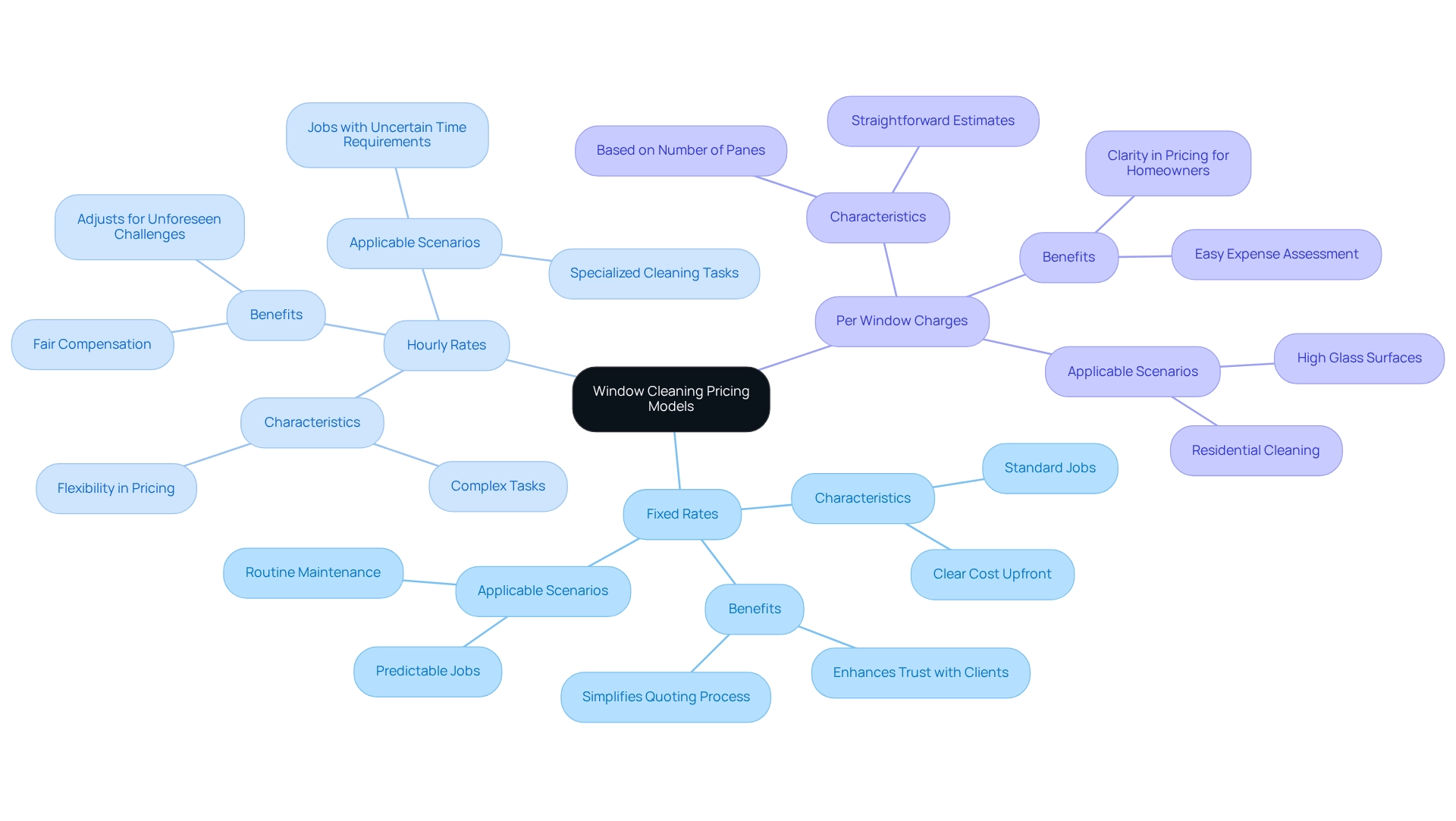
Window Size and Type: Key Determinants of Cleaning Costs
The dimensions and category of openings can significantly impact maintenance expenses, a reality that many contractors face. Larger openings or those featuring multiple panes often require additional time and effort to clean, which leads to increased window cleaning costs that can weigh heavily on both contractors and homeowners. For instance, transom openings, which average around $430 each, can serve ornamental or practical purposes, and their dimensions greatly influence the maintenance process. This window cleaning cost implication is crucial for contractors to consider when developing their pricing strategies, as it directly affects the overall job estimate.
Contractors must also recognize that specialized panes, such as stained glass or those with intricate designs, demand extra attention and specific maintenance techniques, which further influences the overall window cleaning cost. The time required to clean various types of glass can vary significantly; for example, cleaning a standard double-hung opening may take much less time than maintaining a large bay structure or a set of casement openings. This variance in time can directly affect labor costs, potentially resulting in a few hundred to several thousand dollars in savings for homeowners, which can also impact their window cleaning cost when they choose DIY installations.
Moreover, case studies reveal that homeowners can achieve substantial savings by replacing several panes simultaneously, often resulting in better discounts and labor rates from manufacturers. This insight is invaluable for contractors when estimating job prices, as bulk replacements can enhance profitability and foster stronger relationships with clients. Utilizing Field Complete’s comprehensive field service management software can empower contractors to streamline their scheduling, estimating, and payment collection processes, making it easier to manage these dynamics effectively.
Professional assessments indicate that energy-saving panes not only qualify for rebates and tax incentives but can also influence maintenance expenses due to their unique design and materials. As Jessica Ehrlichmann, Vice President and General Manager of Windows and Doors at Andersen, notes, “Homeowners can save money by selecting energy-efficient panes that qualify for rebates and tax credits.”
In conclusion, when evaluating the expenses associated with glass maintenance, contractors must carefully assess the size and type of openings, as these factors significantly influence both the time needed for upkeep and the window cleaning cost. Additionally, comparing costs from various contractors and suppliers can provide practical insights for optimizing financial strategies. By leveraging tools like Field Complete, contractors can improve their operational efficiency, ensuring they remain competitive and responsive to their clients’ needs.
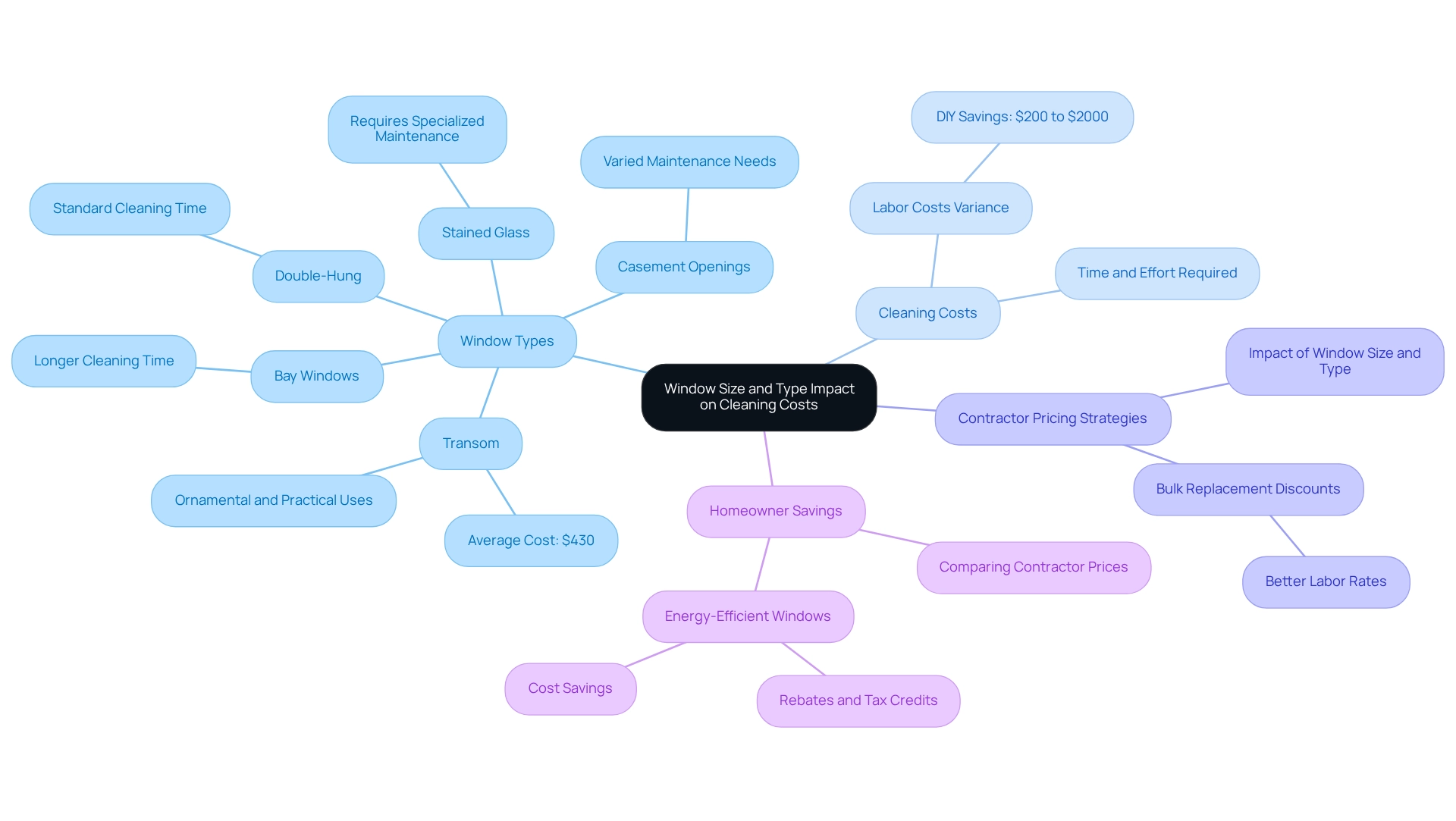
Cleaning Frequency: How Regularity Affects Pricing
The regularity of glass maintenance is crucial for effectively managing window cleaning costs. When maintenance is planned regularly, it not only helps keep windows in optimal condition but also often leads to a reduction in window cleaning cost, offering financial relief to clients. For example, those who choose monthly or quarterly services typically enjoy lower window cleaning costs per visit compared to clients opting for a one-time thorough cleaning. This pricing strategy not only encourages ongoing maintenance but also nurtures customer loyalty and satisfaction.
Enhanced Service Plans, which include regular window cleaning, provide significant window cleaning cost savings, price locking, and additional benefits such as one FREE bug screen cleaning and conditioning each year, along with automated scheduling. These plans ensure that customers experience consistent cleanliness and effortless assistance, ultimately enhancing their overall satisfaction.
As Jeff Aroff from Legacy Maintenance insightfully notes, “The streamlined access to job-related information highlights the platform’s effectiveness in boosting productivity,” a key factor for providers managing pricing strategies. Insights from contractors indicate that offering flexible scheduling for maintenance can significantly strengthen customer loyalty, creating a win-win situation for both providers and clients.
Furthermore, the window cleaning cost can typically be reduced by 10% to 20% for standard glass maintenance, depending on frequency, underscoring the importance of adhering to a regular upkeep plan. By increasing the attach rate of maintenance agreements, contractors can not only boost profitability but also enhance customer satisfaction and loyalty.

Geographical Location: Regional Pricing Variations
Understanding the geographical position is crucial for contractors, as it significantly affects window cleaning cost. Urban regions often face higher labor costs and increased demand for assistance, leading to escalated window cleaning costs. For instance, the window cleaning cost in metropolitan areas can be up to 30% higher than in rural locations, reflecting not only the increased cost of living but also the competition for skilled workers. This can be a source of stress for contractors trying to balance their pricing with operational costs. In contrast, rural areas frequently benefit from lower rates, including window cleaning cost, due to diminished competition and reduced operational expenses, which makes them more appealing for cost-conscious consumers. Contractors must conduct thorough research on regional market rates, including window cleaning cost, to ensure their fees remain competitive while adequately covering costs. A contractor in a bustling city may find it necessary to adjust their pricing strategy for window cleaning cost to account for higher overheads, while one in a less populated area might discover opportunities to offer more competitive rates without sacrificing profit margins. This adaptability is essential for fostering a sustainable business.
Comprehending the attach rate is vital for contractors aiming to enhance profitability. A mere 5% increase in the attach rate can yield substantial financial benefits, as highlighted by research from the Aberdeen Group. This underscores that contractors who effectively manage their contracts can not only boost their income but also enhance customer satisfaction and loyalty. Expert insights emphasize that understanding the window cleaning cost differences across regions is key to a successful business strategy. Contractors have noted that tailoring their offerings to local economic conditions can lead to improved customer satisfaction and loyalty.
For example, a contractor working in a major metropolitan area realized that their pricing strategy needed to adapt to the high demand and labor costs, while another in a rural setting successfully maintained lower rates, attracting a steady stream of customers. Jeff Aroff from Legacy Maintenance emphasized the importance of having efficient access to job-related information, stating that it enhances productivity and aids contractors in adjusting their pricing strategies effectively. By leveraging insights from local market conditions and focusing on improving their attach rates, contractors can optimize their pricing strategies, maximizing both profitability and service quality. This approach not only supports their business growth but also fosters a sense of community and trust with their customers.

Window Condition: Impact on Cleaning Time and Cost
The condition of your panes can significantly affect both the time and the window cleaning cost associated with maintenance. When panes are severely dirty, have mineral buildup, or have been neglected for an extended period, they require more time and specialized solutions, which can increase the overall window cleaning cost. It’s essential for contractors to assess these openings before providing quotes, as this ensures an accurate representation of the window cleaning cost along with the additional labor and materials needed for the job.
Imagine the relief of knowing that you can manage these challenges more effectively. By utilizing Field Complete’s contractor management software, HVAC contractors can streamline their workflow to fit their unique maintenance procedures. This software not only organizes all documents and records related to each job but also makes them easily accessible. Such organization allows for better estimation and scheduling, ultimately enhancing customer satisfaction and promoting smoother operations.
It’s not just about efficiency; it’s about creating a supportive environment for your team and clients. With the right tools, you can transform how you approach maintenance, ensuring that every job is handled with care and precision.
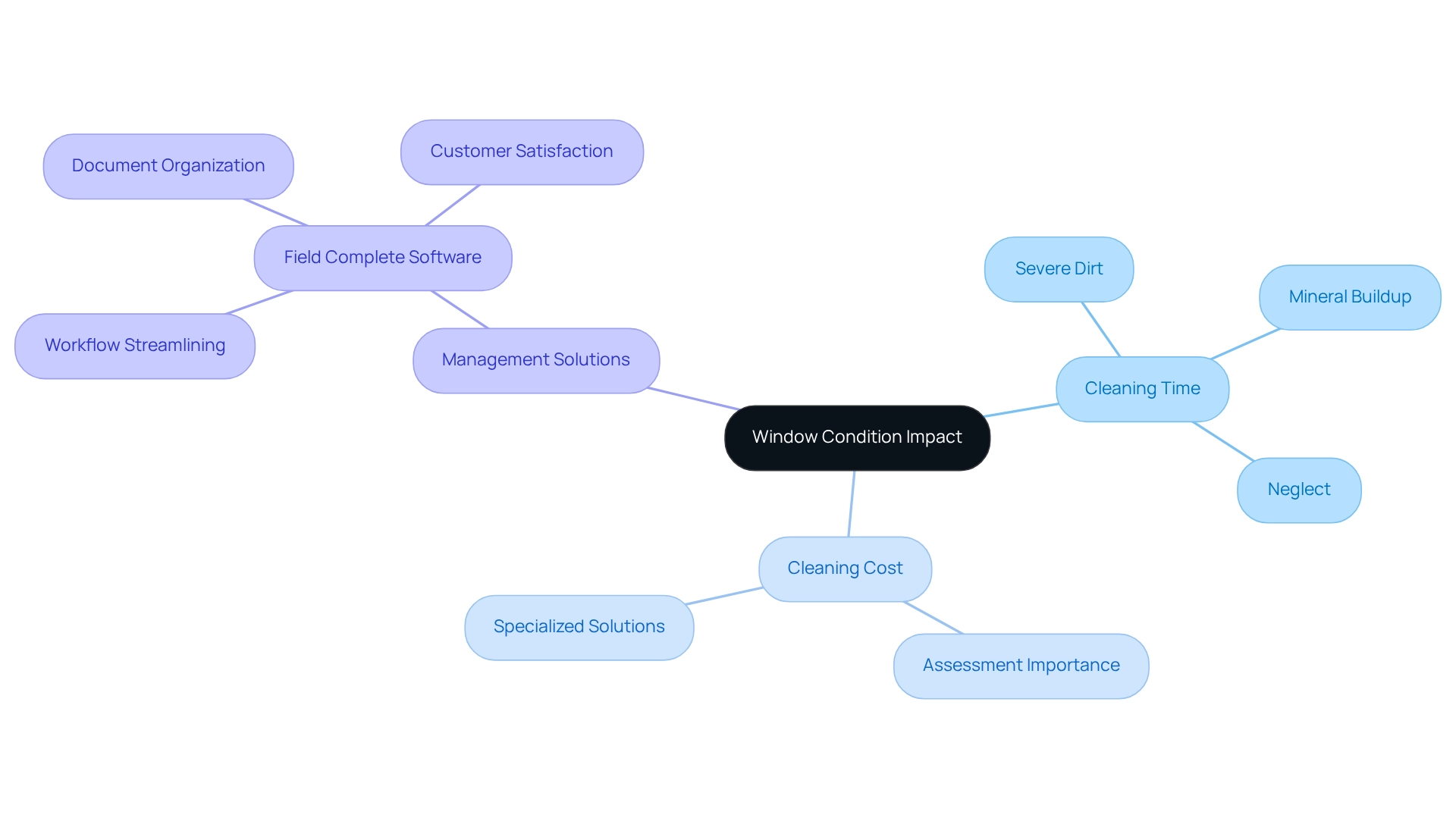
Specialized Services: Pricing for High-Rise and Post-Construction Cleaning
Specialized offerings such as high-rise glass maintenance and post-construction tidying can often feel overwhelming due to their inherent complexity and related risks, leading to higher costs. High-rise maintenance, for instance, necessitates specialized tools and trained staff, which can result in hourly rates that significantly exceed those of typical residential assistance. The window cleaning cost for high-rise glass maintenance typically ranges from $10 to $15 per pane, influenced by the structure’s height and accessibility. Additionally, external sanitation services, like pressure washing paved areas and driveways, further illustrate the pricing landscape within the maintenance industry, which can be daunting for contractors trying to navigate these costs.
Post-construction tidying presents its own set of challenges, involving additional labor to remove debris and ensure windows are immaculate, justifying a premium charge. This process often requires a thorough tidy-up that includes removing large debris, wiping down surfaces, and performing a final wash to prepare the area for use. As highlighted in the case study titled “Post Construction Cleaning Process,” such structured approaches not only enhance the presentation of the space but also ensure that all aspects of the cleaning are meticulously covered, alleviating some of the stress contractors may feel.
To effectively manage these cost structures, contractors can turn to Field Complete’s streamlined estimation and quoting features as a supportive solution. By generating precise estimates and utilizing adaptable templates, contractors can convey costs to clients transparently, emphasizing the value of the specialized offerings they provide. Real-time approval alerts enhance the efficiency of the quoting process, fostering quicker client responses and improved cash flow, which is essential for maintaining a healthy business.
Accessibility issues can further influence window cleaning cost; for example, areas that are difficult to access or located on higher floors may incur additional charges. This is especially pertinent in high-rise maintenance, where the complexities involved can greatly affect the window cleaning cost. Understanding these elements, along with the significance of the attached rate—where a higher percentage of contracted offerings can lead to enhanced profitability—empowers contractors to manage client expectations effectively and validate the window cleaning cost related to high-rise and post-construction glass maintenance. As Jeff Aroff from Legacy Maintenance expressed, the streamlined access to job-related information significantly improves productivity, which is vital in providing quality support and justifying costs.
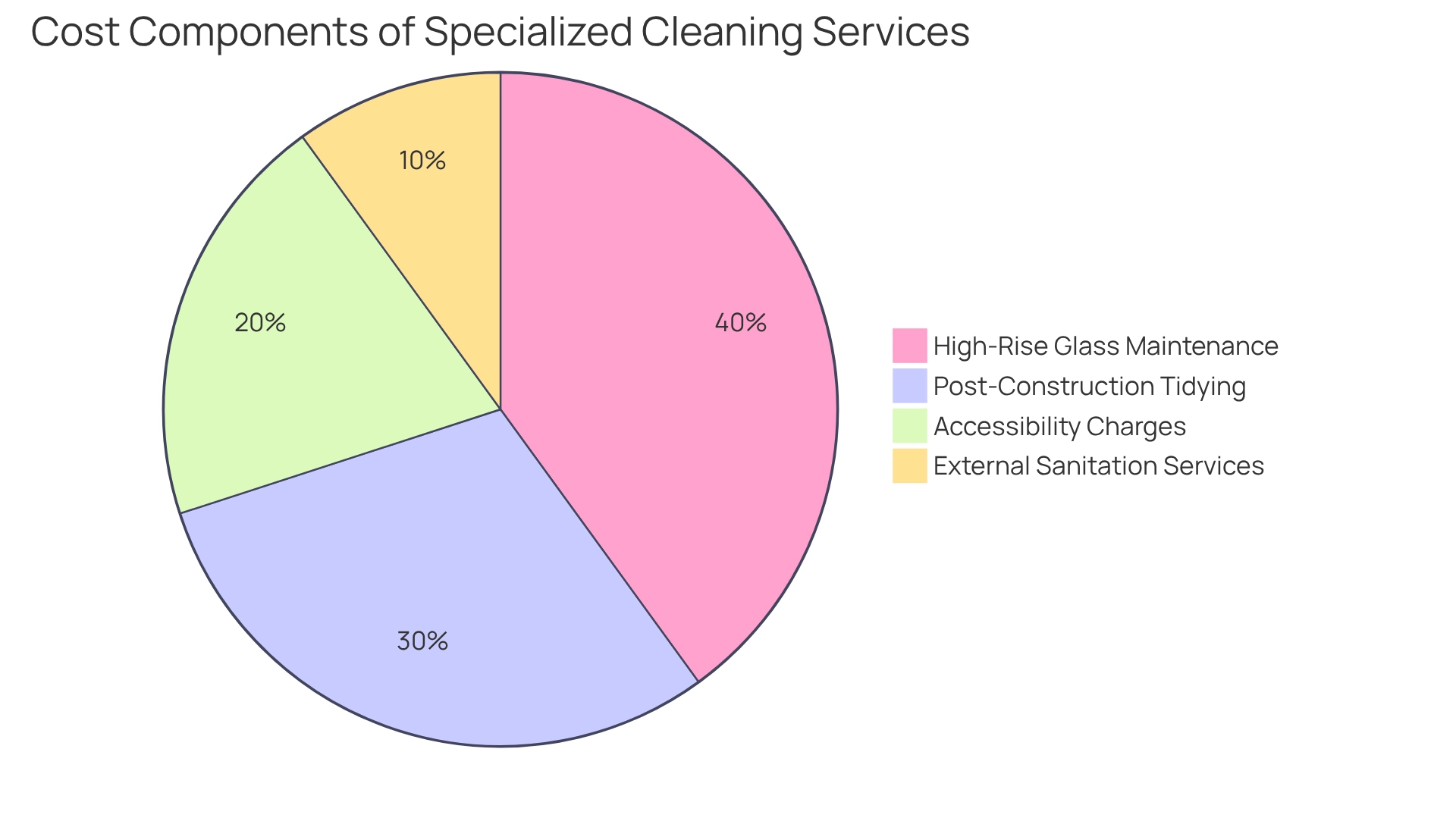
Labor Costs: Understanding the Impact on Pricing
Labor costs represent a significant portion of expenditures in glass cleaning operations, creating challenges for contractors striving to remain competitive. Whether working solo or leading a team, they must consider wages, benefits, and overhead when setting their rates. In 2025, the window cleaning cost typically ranges from $40 to $75 per hour, with variations influenced by experience and geographic location. For example, entry-level cleaners may begin at the lower end of this spectrum, while seasoned professionals often command higher rates due to their expertise and efficiency.
Understanding labor costs is essential for contractors who wish to balance competitiveness with profitability. A case study titled “Incorporating Specialized Cleaning Solutions into the Estimate” underscores the importance of integrating specialized offerings into cost estimates to meet specific client needs. This approach not only elevates quality but also enhances overall cleanliness and aesthetics, providing clients with tailored solutions that resonate with their unique requirements.
Current statistics reveal that the window cleaning cost can fluctuate significantly by region, reflecting local market conditions and demand. Urban areas, for instance, may experience higher labor costs due to elevated living expenses, while rural regions may present lower rates. Experts emphasize that maintaining precise and adaptable estimates is vital for boosting customer satisfaction and service quality, allowing contractors to adjust their cost strategies in response to labor expenses effectively.
Moreover, enhancing profitability through strategies like increasing the attach rate can lead to substantial financial benefits. Research from Aberdeen Group indicates that even a modest 5% rise in the attach rate can result in an impressive 9% growth in income. This highlights the importance of having reliable data to inform cost strategies. As Jeff Aroff from Legacy Maintenance remarked, “The streamlined access to job-related information emphasizes the platform’s effectiveness in enhancing productivity.” Ultimately, understanding how labor expenses impact window cleaning cost empowers contractors to make informed decisions, ensuring they can deliver quality work while achieving their financial goals.
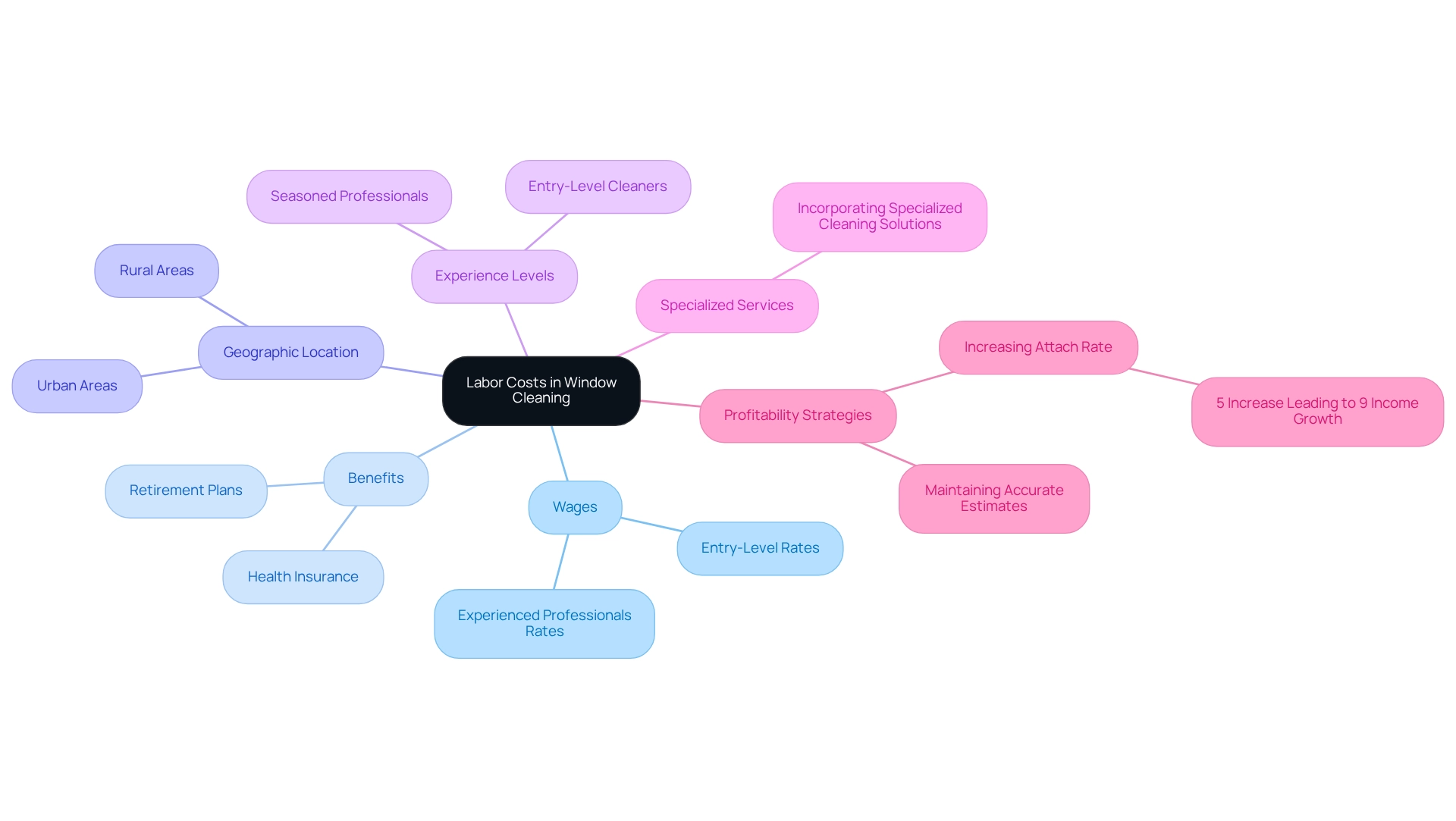
Equipment and Supplies: Their Role in Pricing Structure
The quality and standard of tools and materials used in glass washing are vital in shaping the window cleaning cost and overall operational success. As contractors, you understand that high-quality squeegees, specialized maintenance solutions, and reliable safety equipment not only improve the effectiveness of your work but also play a significant role in enhancing customer satisfaction. By investing in superior tools, you can experience a remarkable boost in efficiency, allowing you to complete jobs more swiftly and achieve better results. This increased efficiency can lead to substantial cost savings and potentially higher profit margins.
However, navigating the financial landscape can be challenging. The average window cleaning cost for equipment and supplies in 2025 indicates a growing trend toward premium products, which can range from $200 to $1,000 based on brand and specifications. It is essential for contractors to integrate window cleaning cost into their financial strategies, as the initial investment in quality equipment often translates into benefits through reduced labor time and improved quality of service.
Moreover, embracing streamlined software solutions like Field Complete can significantly enhance your job management and invoicing processes. Features such as Easy Estimation and Automated Approval empower contractors to refine their operations, positively impacting cost strategies. Regular maintenance of equipment is equally crucial; consistent upkeep can avert unexpected breakdowns and costly repairs that could disrupt service delivery and affect your profitability. Industry experts emphasize that investing in premium maintenance products is not merely an expense but a strategic decision that can profoundly influence cost structures, such as window cleaning cost, and foster customer loyalty. Orestes Monterrey, President, shared, “GreenTech’s ability to specify the needed upgrades in a precise fashion helped us gain a better idea of exactly what we were paying for.”
For instance, case studies reveal that businesses that upgraded their maintenance tools saw a 30% increase in job completion rates, directly enhancing their cost management capabilities. The complete LED lighting upgrade for Florida Marine Tanks resulted in a remarkable 74% reduction in annual lighting energy usage, achieving a payback period of just 1.8 years and $17,379 in annual operating savings. This illustrates the tangible financial benefits of investing in quality equipment.
In conclusion, the importance of tools and materials in relation to window cleaning cost cannot be overstated. By prioritizing quality and upkeep, alongside leveraging comprehensive software solutions like Field Complete, you can ensure that you remain competitive while delivering exceptional support to your clients.

Customer Expectations: How Communication Influences Pricing
Effective communication is essential for meeting customer expectations and clarifying window cleaning cost. Contractors often face the challenge of ensuring their quotes clearly outline the services provided, including the window cleaning cost and any potential additional costs that may arise from unique circumstances or specific client requests. This level of transparency is not just a best practice; it nurtures trust, paving the way for repeat business and valuable referrals.
By genuinely listening to customer needs and preferences, contractors can tailor their offerings, leading to enhanced customer satisfaction and the opportunity for premium pricing. Research shows that clear communication plays a pivotal role in shaping customer perceptions of value, making it vital for contractors to embrace effective strategies that foster transparency and responsiveness.
Matthew Miller, CEO of OnSite Mastery, highlights how Field Complete’s customer success program—rooted in comprehensive training and data-driven insights—significantly enhances communication and operational efficiency. Moreover, Field Complete’s maintenance business software streamlines invoicing and improves organization, supporting contractors in effectively managing customer expectations.
A case study featuring a local window cleaning company that collaborated with a nearby organization illustrates how community involvement and openness can positively impact customer relationships. Ultimately, prioritizing communication during discussions about window cleaning cost not only aligns expectations but also positions contractors as trustworthy providers in a competitive landscape.
Furthermore, Field Complete’s recognition as one of the top franchises in Entrepreneur’s Franchise 500 in 2022 underscores the critical role of effective communication and operational efficiency in the home services sector.
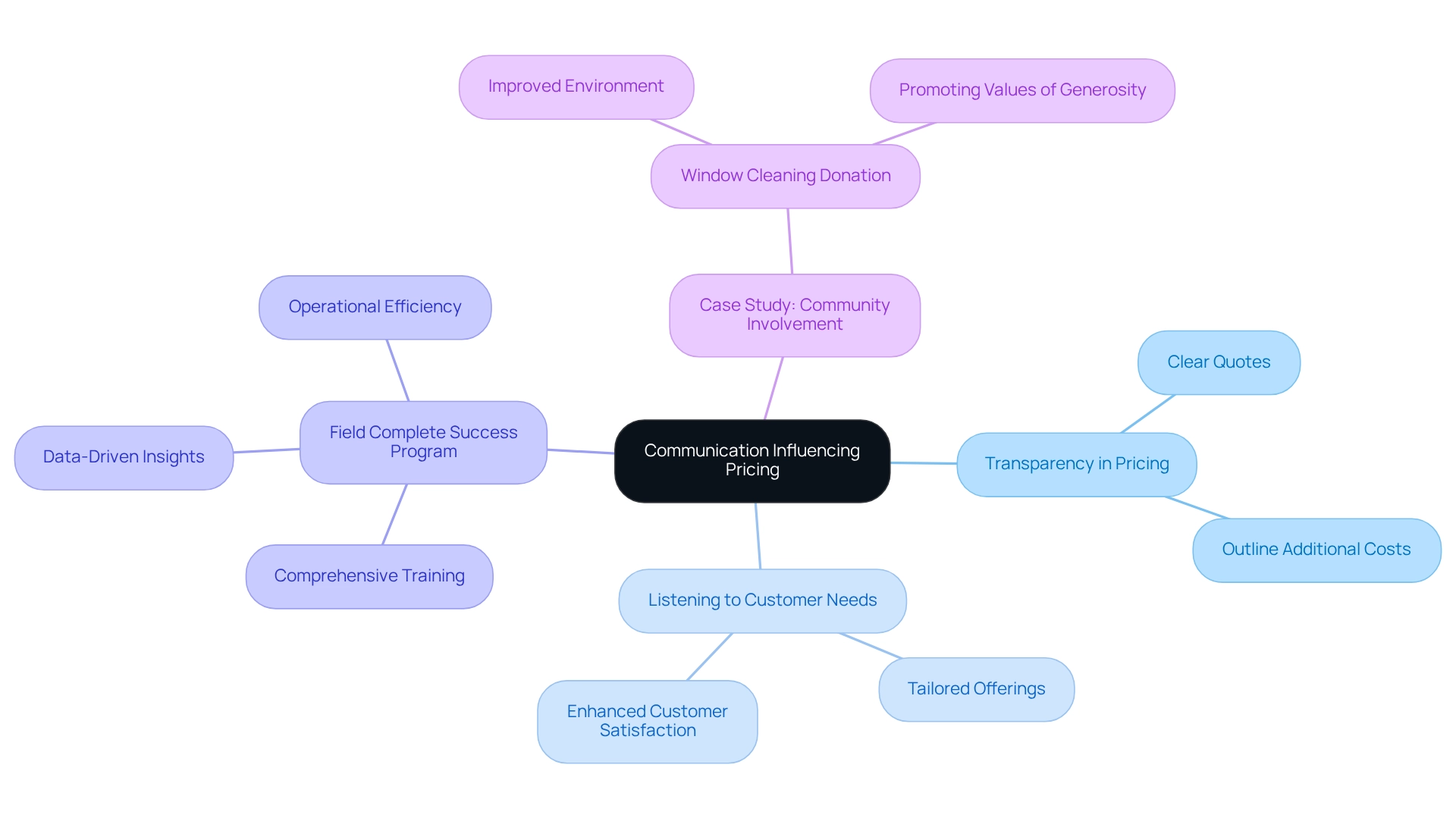
Conclusion
Understanding the complexities of pricing in the window cleaning industry can feel overwhelming for contractors striving to succeed in a competitive environment. The myriad factors influencing pricing—from window size and type to labor costs and geographical location—highlight the necessity for a well-rounded pricing strategy. By embracing effective communication and utilizing management software like Field Complete, contractors can not only streamline their operations but also enhance their service offerings and cultivate enduring relationships with their clients.
Moreover, it’s essential to recognize how cleaning frequency and customer expectations play a significant role in customer satisfaction and retention. Regular maintenance not only keeps windows in optimal condition but also enables cost-effective pricing models that resonate with clients. By attuning to market trends and customer needs, window cleaning professionals can adeptly navigate the intricacies of pricing while safeguarding their profitability.
In conclusion, adopting these strategies and insights empowers contractors with the essential tools to refine their pricing and operational approaches. As the industry continues to evolve, remaining informed and adaptable will be crucial for achieving lasting success and maintaining a competitive edge in the window cleaning market. By prioritizing quality service and efficient management, contractors can foster a supportive community that thrives on mutual growth and satisfaction.
Frequently Asked Questions
What challenges do contractors face in glass maintenance?
Contractors in glass maintenance face challenges such as chaotic job scheduling and difficulties in managing customer relationships, which can lead to frustration and inefficiency.
How does Field Complete address these challenges?
Field Complete offers solutions like streamlined job scheduling, efficient dispatching, and robust customer management to help contractors automate routine tasks and improve service quality.
What features does Field Complete provide to enhance operational efficiency?
Field Complete provides features such as easy subcontracting, mobile accessibility for technicians, real-time tracking of team locations, and optimized routing to boost productivity.
Can small businesses access Field Complete for free?
Yes, small businesses can access the software for free, allowing them to assign tasks easily and enhance operational efficiency.
What pricing models are commonly used for window cleaning services?
Common pricing models include fixed rates for standard jobs, hourly rates for complex tasks, and per pane charges for residential services.
How do fixed rates benefit contractors and clients?
Fixed rates simplify the quoting process for contractors and enhance trust with clients by providing clear upfront costs.
When are hourly rates more advantageous?
Hourly rates are advantageous for complex jobs that may require additional time and effort, allowing contractors to adjust costs based on actual time invested.
What is the significance of understanding the attach rate in pricing strategies?
Understanding the attach rate, which measures the percentage of total products under contract, can significantly enhance profitability, with even a small increase leading to substantial income growth.
How do the dimensions and category of openings affect maintenance expenses?
Larger openings or those with multiple panes require more time and effort to clean, leading to increased costs for both contractors and homeowners.
What insights can contractors gain from using Field Complete’s software?
Contractors can streamline scheduling, estimating, and payment collection processes, improving operational efficiency and responsiveness to client needs.
List of Sources
- Pricing Models: Fixed, Hourly, and Per Window Rates
- How Much Should I Expect to Pay for Window Cleaning? | Pricing Guide (https://property-refresh.com/blog/how-much-should-i-expect-to-pay-for-window-cleaning-pricing-guide)
- upmetrics.co (https://upmetrics.co/blog/cleaning-industry-statistics)
- Window Size and Type: Key Determinants of Cleaning Costs
- Window Replacement Cost: A Homeowner’s 2025 Guide (https://thisoldhouse.com/windows/window-replacement-cost)
- Cleaning Frequency: How Regularity Affects Pricing
- Lock in Savings with Window Cleaning Enhanced Service Plans (https://squeegeebroswindowcleaning.com/enhanced-service-plans)
- Geographical Location: Regional Pricing Variations
- Pharmaceutical Production Archives | Anguil Environmental Systems, Inc. (https://anguil.com/case_studies_category/pharmaceutical-production)
- demystifying-the-price-tag-what-affects-window-cleaning-costs | jasperrcwa (https://jasperrcwa.bloggersdelight.dk/2025/04/20/demystifying-the-price-tag-what-affects-window-cleaning-costs-2)
- Specialized Services: Pricing for High-Rise and Post-Construction Cleaning
- fixr.com (https://fixr.com/costs/post-construction-cleaning)
- Labor Costs: Understanding the Impact on Pricing
- Cleaning Cost Estimator Tool: How to Estimate and Save on Your Cleaning Services – FasterCapital (https://fastercapital.com/content/Cleaning-Cost-Estimator-Tool–How-to-Estimate-and-Save-on-Your-Cleaning-Services.html)
- Equipment and Supplies: Their Role in Pricing Structure
- Case Study | GreenTech Solutions Group, LLC. (https://greentechsolutionsgroup.com/case_studies)
- Case Studies Archive – Gurobi Optimization (https://gurobi.com/case_studies)
- Customer Expectations: How Communication Influences Pricing
- In the News | Fish Window Cleaning (https://fishwindowcleaning.com/Saint-Paul-MN-863/about/in-the-news)
- Top 25 Customer Experience Quotes to Inspire You in 2025 (https://racami.com/top-25-customer-experience-quotes-to-inspire-you-in-2021)





